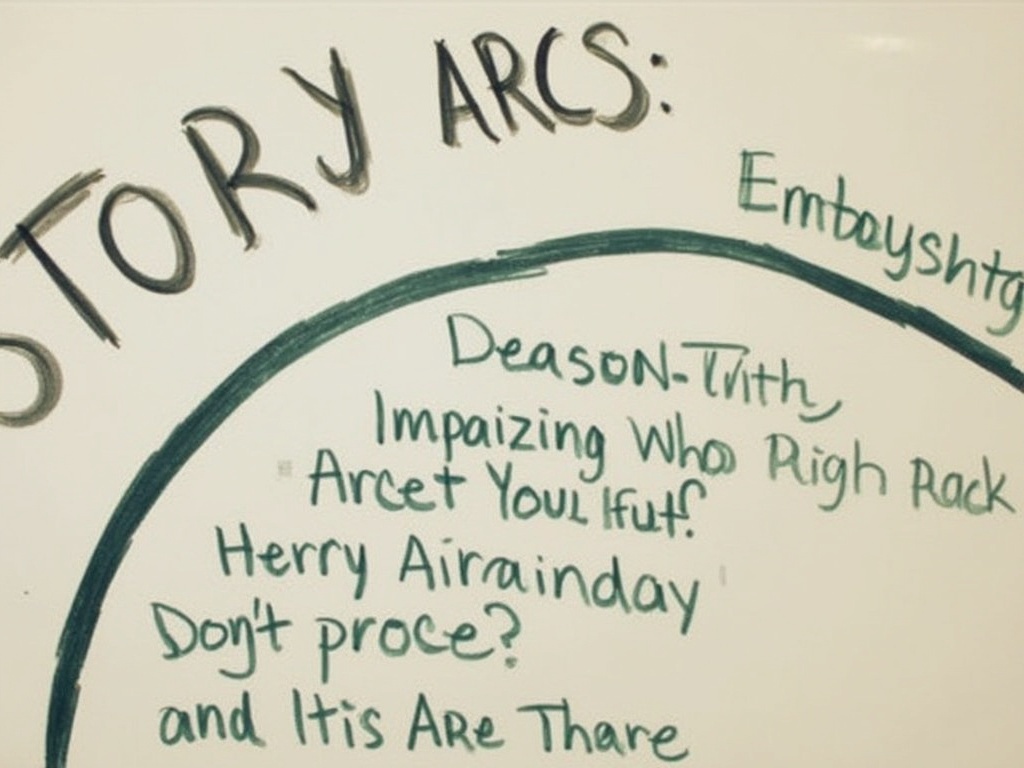Story arcs form the emotional and structural backbone that guides readers through a narrative journey, balancing character development with plot progression to create meaningful connections. Modern technology and AI tools have revolutionized how writers craft these arcs, offering frameworks that streamline the creative process while preserving the authentic voice that makes stories resonate with audiences.
Key Takeaways:
- Traditional story arcs follow a five-point structure including exposition, rising action, climax, falling action, and resolution
- There are seven archetypal plots identified by Christopher Booker, providing fundamental frameworks for most narratives
- Understanding the distinction between plot, story arc, and character arc is crucial for effective storytelling
- AI and technology tools can help writers develop more cohesive narrative structures
- Contemporary approaches to storytelling often intentionally subvert traditional story arcs
Understanding Story Arcs: The Foundation of Narrative
The concept of story arcs has been central to storytelling since ancient times, providing the fundamental structure that carries readers through emotional and thematic journeys. At its core, a traditional story arc follows a five-point structure: Exposition, Rising Action, Climax, Falling Action, and Resolution. This pattern creates a sense of momentum, tension, and satisfaction that keeps readers engaged from beginning to end.
The arcs of a story aren’t just about what happens in the plot—they’re about how events transform characters and explore themes. For example, in Star Wars, Luke Skywalker’s journey from farm boy to Jedi follows a classic arc that balances external conflicts (battling the Empire) with internal growth (discovering his potential and heritage). Similarly, The Hunger Games uses its dystopian setting to chart Katniss Everdeen’s transformation from reluctant participant to revolutionary symbol.
Writers often ask how many arcs should a story have, but the answer depends on the complexity of your narrative. A short story might contain a single, focused arc, while novels and films frequently feature a main arc with several supporting subplots that enhance the primary narrative. The key is ensuring these different story arcs complement rather than compete with each other.
The Anatomy of Different Story Arc Types
Literary scholar Christopher Booker identified seven archetypal plots that form the basis for most narratives: Overcoming the Monster, Rags to Riches, The Quest, Voyage and Return, Comedy, Tragedy, and Rebirth. Each of these fundamental patterns provides a distinct emotional journey for both characters and readers. For instance, Cinderella exemplifies the Rags to Riches arc, while Dracula represents the Overcoming the Monster structure.
Beyond these classic frameworks, modern storytelling has developed variations including The Fall (a downward trajectory) and the Hero’s Journey (a rise-fall-rise cycle). Each type of arc serves different storytelling purposes and evokes specific emotional responses from audiences. The Hero’s Journey, popularized by Joseph Campbell, appears in countless stories from ancient myths to modern blockbusters.
Here are some common story arc patterns and their notable examples:
- Tragic Arc: Shows a protagonist’s downfall due to a fatal flaw (Macbeth)
- Redemption Arc: Chronicles a character’s journey from moral failure to atonement (A Christmas Carol)
- Coming-of-Age Arc: Follows a character’s transition from youth to maturity (To Kill a Mockingbird)
- Transformation Arc: Depicts radical change in a character’s identity or beliefs (The Matrix)
Understanding these different arc types gives writers a toolbox of structures to draw from when crafting their narratives. The choice of arc dramatically impacts how readers experience the story and what emotional journey they’ll embark upon through its pages.
Plot vs. Story Arc vs. Character Arc: Critical Distinctions
Writers sometimes confuse plot, story arc, and character arc, but each serves a distinct function in narrative construction. The plot refers to the specific sequence of events that occur—what literally happens in your story. In Inception, the plot involves a team entering dreams to plant an idea. Plot points are the individual events that move the story forward.
A story arc, however, encompasses the emotional and thematic journey that these plot events create when strung together. It’s about the rising and falling tension and how the narrative’s energy flows from beginning to end. Star Wars doesn’t just detail events; it charts a rebellion’s struggle against tyranny and connects these events in a meaningful progression.
Character arcs focus specifically on how individuals change throughout the narrative. Ebenezer Scrooge’s transformation in A Christmas Carol from miser to philanthropist represents a classic character arc. The most compelling storytelling techniques integrate all three elements—plot, story arc, and character arc—to create narratives where external events trigger internal changes that advance the overall thematic journey.
This integration creates resonance for readers, as they experience both the excitement of plot developments and the satisfaction of meaningful character growth within a well-structured emotional framework. When working harmoniously, these elements make stories feel both surprising and inevitable—exactly the balance that keeps readers turning pages.
How AI and Technology Transform Story Development
The emergence of AI and story arcs tools has revolutionized how writers approach narrative structure. Platforms like Beam.ai’s Story Arc Development tool now automate the creation of structured plot summaries, generating 300-500 word outlines that include all essential arc elements. This technological assistance helps writers maintain narrative coherence while freeing creative energy for character development and thematic exploration.
These tools offer significant advantages: reducing writer’s block by providing structural templates, saving time during planning stages, and improving how past events integrate into ongoing narratives. Writers simply input key themes, characters, and pivotal moments, and the AI suggests potential narrative pathways based on established storytelling principles.
AI is changing storytelling by offering immediate feedback on pacing, tension, and emotional arcs. Modern software can analyze drafts to identify where story tension lags or where character motivations lack clarity. This objective analysis helps writers spot structural issues that might otherwise require multiple revision rounds to identify.
For newer writers especially, these tools provide training wheels for understanding narrative structure. By seeing how AI organizes story elements according to proven principles, writers develop an intuition for effective storytelling that eventually becomes second nature. The technology doesn’t replace creativity but rather provides a supportive framework for channeling it effectively.
Implementing Effective Story Arcs in Your Writing
Creating compelling story arcs begins in the pre-writing phase, where technological tools can help map key events and emotional beats. Start by identifying your protagonist’s initial state and their ultimate transformation, then plot the crucial turning points that will drive this change. Software like Plottr or Scrivener offers visualization tools that make this process more intuitive.
During drafting, focus on balancing external plot events with internal character moments. Each major plot point should trigger meaningful emotional reactions or decisions from your characters. This balance ensures readers remain invested in both what happens and why it matters. Consider these essential elements when implementing story arcs:
- Establish clear stakes early to give the arc meaningful tension
- Create escalating complications that test your protagonist’s resolve
- Ensure the climax addresses both external conflict and internal character journey
- Design a resolution that demonstrates meaningful change from the starting point
During revision, check that your arc elements align with the protagonist’s emotional journey. Each scene should either advance the plot or develop character—ideally both. Beta readers can help identify where emotional resonance falls flat or where plot developments feel contrived rather than organic consequences of character choices.
Remember that effective arcs don’t just move forward—they also contain callbacks and echoes to earlier moments, creating a sense of narrative cohesion. Technology tools can help track these connections, ensuring your story feels like an integrated whole rather than a series of disconnected events.
Breaking the Mold: Contemporary Approaches to Story Arcs
While traditional arcs provide proven frameworks, contemporary storytelling often deliberately subverts these structures to create fresh experiences. Non-linear narratives like Memento challenge conventional chronology, forcing audiences to piece together fragmented storylines in ways that mirror the protagonist’s mental state. These approaches can create powerful effects when the structure itself conveys thematic meaning.
Multi-protagonist arcs have become increasingly common in ensemble stories like The Avengers, where several characters experience unique transformations that intertwine to form a more complex overall narrative. This approach requires careful balancing of screen time and emotional investment across multiple journeys.
Digital storytelling environments have expanded possibilities further, allowing for branching narratives where readers or viewers make choices that affect story outcomes. Interactive fiction, video games, and AI story world builders create experiences where traditional arcs become more fluid and responsive to audience participation.
These innovations don’t invalidate traditional structures but rather build upon them in creative ways. Even the most experimental narratives typically maintain some form of emotional progression and transformation—the essence of what makes story arcs effective. The most successful contemporary approaches understand the rules they’re breaking and do so with deliberate purpose rather than random experimentation.
Leveraging Technology for Your Story Arc Development
Today’s writers have access to an unprecedented array of tools designed specifically for narrative development. Visualization software like Aeon Timeline and Dramatica Pro helps map complex stories across time and viewpoint characters, making it easier to track multiple narrative threads simultaneously. These tools are particularly valuable for series writing or stories with complex timelines.
AI-driven analysis tools can now evaluate manuscripts for pacing and emotional beats, highlighting sections where tension lags or where character motivations need clarification. Programs like ProWritingAid and AutoCrit include story analysis features that identify potential structural weaknesses like inconsistent character behavior or resolution elements that don’t adequately address setup questions.
For educational settings, story structure software provides valuable teaching tools that help students visualize abstract concepts like rising action and climax. These applications create interactive models that demonstrate how changing one story element affects the entire narrative flow.
The future of story arc development likely involves even more sophisticated integration between AI analysis and human creativity. While technology can identify structural patterns and suggest improvements, the emotional resonance that makes stories meaningful remains a uniquely human contribution. The most effective approach combines technological analysis with creative instinct, using each to enhance the other in service of more compelling narratives.
Story arcs form the emotional backbone of narrative, balancing character development with plot to create meaningful connections. Traditional arcs follow a five-point structure—exposition, rising action, climax, falling action, and resolution—though contemporary storytelling often intentionally subverts these patterns. Christopher Booker identified seven archetypal plots that provide fundamental frameworks for most narratives. Writers must understand the distinction between plot (sequence of events), story arc (emotional journey), and character arc (individual transformation) to craft effective stories. Modern AI tools have revolutionized how writers develop these structures, offering frameworks that streamline the creative process while maintaining authentic voice.
| Key Elements | Description |
|---|---|
| Traditional Structure | Five-point progression: exposition → rising action → climax → falling action → resolution |
| Seven Archetypal Plots | Booker’s fundamental frameworks: Overcoming the Monster, Rags to Riches, The Quest, Voyage and Return, Comedy, Tragedy, and Rebirth |
| Narrative Components | Plot (events), story arc (emotional journey), character arc (transformation) |
| Technology’s Role | AI tools help writers maintain narrative coherence while freeing creative energy for deeper character and thematic development |
| Contemporary Approaches | Modern storytelling often deliberately subverts traditional structures with non-linear narratives and multi-protagonist arcs |



